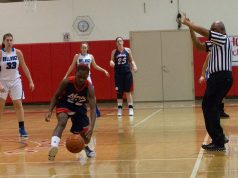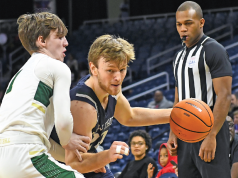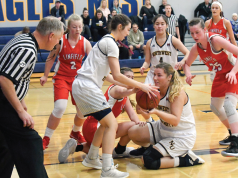At best, it’s an unnecessary delay that interrupts the flow of the game.
At worst, it’s an open invitation for gamesmanship that complicates critical moments of the game.
Whether it’s to prevent coaches from taking a de facto timeout on the floor, players from talking trash in a crowded lane or your crew from losing track of the proper free-throw shooter or situation, the governing bodies all agree: Free-throw huddles don’t belong in basketball, and you and your crew should work to eliminate them.
The NFHS, NCAA men’s and NCAA women’s rulebooks all consider free-throw huddles a delay of game, which requires officials to administer a warning on the first offense, followed by a technical foul on subsequent instances. But some of the simplest means of prevention can be the most effective. For starters, officials can set an example for players to follow during the dead-ball period following a foul by hustling to the scorer’s table to report the foul.
In his 2017 summer mechanics memo, NCAA National Coordinator of Men’s Basketball Officiating J.D. Collins reminded officials, “Walking to the table from lead is unacceptable, put some zip into your movement to report.” By jogging to the reporting area instead of taking a leisurely stroll, you can shorten the dead-ball period and send an unspoken message to teams that pace of play is a priority.
However, per both the NFHS and CCA manuals, calling officials should report to the scorer’s table only after communicating to the players and the rest of the crew who will shoot the free throws and how many free throws the shooter will attempt. Armed with that knowledge, non-calling officials then can reinforce the message being sent by the briskly moving calling official.
Deliver your message with a firm voice
Even as bodies congregate in the lane, non-calling officials must stay focused on which player will attempt the free throws and shepherd players into the appropriate lane spaces with simple verbal cues such as “Let’s line up,” “We’re shooting one-and-one,” or “No. 25 is shooting two.” If necessary, take an extra step or two toward the free-throw line or into the middle of the lane to deliver your message with a firm voice that can be heard above the noise of the crowd.
Calling and non-calling officials alike also must avoid the temptation to linger near the scorer’s table or bench areas and engage in idle chatter after every call. If discussion of an unusual situation such as a correctable error is necessary, direct players to their respective bench areas before gathering with your crew, then move on as soon as the issue has been resolved. Communicating with partners and coaches is an essential duty for all officials, but leaving huddled players unsupervised can raise the risk of unsportsmanlike behavior to critical levels.
Finally, if players continue to huddle up prior to free throws despite all your best attempts at diplomacy, simply enforce the rules of your game as they are written and penalize the illegal action. Administer a delay-of-game warning, which is recorded in the official scorebook and gives warning to the offending team’s coach, after the first offense, then assess a technical foul — a Class B technical by NCAA men’s rules, an administrative technical by NCAA women’s rules and a team technical per NFHS rules — for each subsequent violation.
Also, be aware of different language for delay-of-game situations between NCAA and NFHS rules, as a free-throw huddle is one of four unique delay-of-game situations according to the NCAA rulebook, but is covered by a catch-all delay-of-game rule according to the NFHS.
Issuing a technical foul may seem to some like a reactive measure rather than a proactive one, but it usually prevents repeat offenders. And a consistent, crew-wide effort to eliminate free-throw huddles can prevent lengthier delays as your game wears on.
What's Your Call? Leave a Comment:
Note: This article is archival in nature. Rules, interpretations, mechanics, philosophies and other information may or may not be correct for the current year.
This article is the copyright of ©Referee Enterprises, Inc., and may not be republished in whole or in part online, in print or in any capacity without expressed written permission from Referee. The article is made available for educational use by individuals.


















